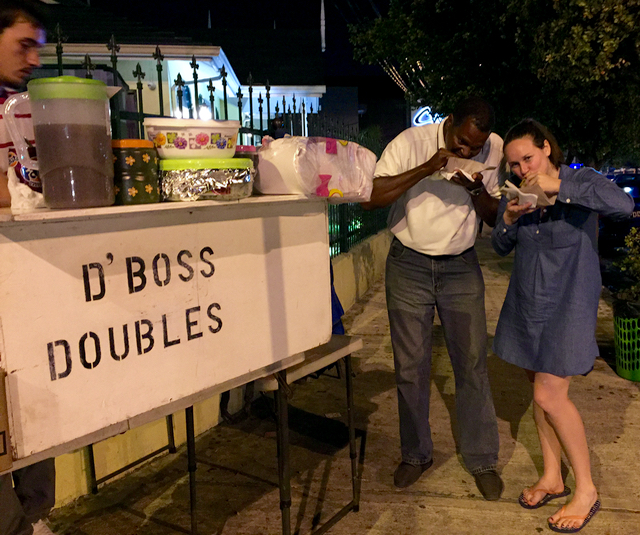
A Lesson in Liming with Trinidad Food Tours
I’m standing on a corner along Ariapita Avenue in Port of Spain when Anthony Luces, owner of Trinidad Food Tours tells me to put my notebook down.
I’ve wandered with guides down streets in a dozen or so countries writing stories for this blog and not one of them has ever uttered such a phrase, so it comes as quite a shock that here, on this nondescript, dimly lit block in the southerly most country in the Caribbean – Trinidad & Tobago, Anthony is telling me to stop taking notes.
At first his words put me off – I take a very journalistic approach in my writing and journals are a constant in my travels as I record facts and fragments of conversations wherever I go. But soon I come to understand his point of view.
“Feel the moment,” he urges with the genuine passion of a person who really cares about the outcome of my evening in his country.
“If you really experience the evening do you really think you will forget it? It will stick with you in memory,” he adds.
A Lesson in Liming
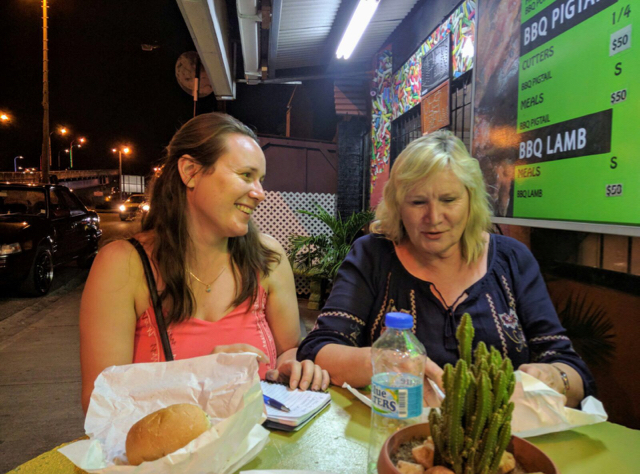
Anthony is teaching me my first lesson in “liming,” as we enjoy a Trinidad food tour. Here lime is not a fruit, but a term Trinis (the people of Trinidad) use as a noun to express their distinctive style of “hanging out.”
“It’s how you breeze out,” Anthony says. “[Liming] is hanging out… socializing in an informal, relaxing environment, especially with friends of family.”
And Anthony has a fair point – in my mission to document the highlights of the evening in my notebook, I’m not liming at all. My rigid focus is holding me back from breezing out and truly experiencing the moment.
Trinidad Food Tour
At Trinidad Food Tours the experience of liming is of equal importance to the cuisine. On our visit to the island my mom and I opted in for the night lime tour that takes place after the sun has set and the streets light up with the delicious fragrance of street food. It’s not the company’s mission to provide guests with pre-packages touristy versions of Trini food, but rather to immerse visitors in the most authentic and beloved cuisine around.
Corn Soup
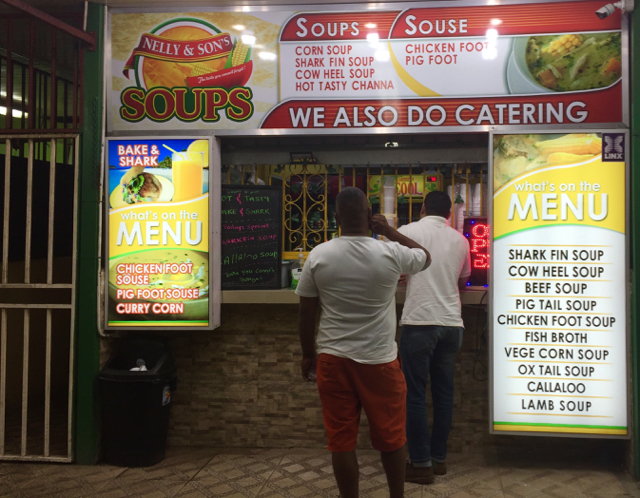
We begin at a local spot near the Grand Bazar in the country’s capital city where we try corn soup. Trinidad is an interesting confluence of cultures hailing from Africa, India and Europe. This diversity of heritage is reflected in the cuisine, and the corn soup serves as an excellent example of this global fusion. The recipe originates from Africa, but contains corn, a vegetable that wasn’t originally found in the region, and Indian spices.
Geera Pork
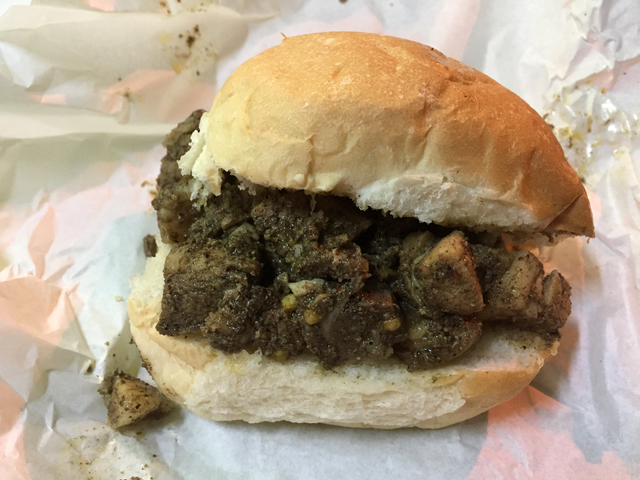
Next up on our plate is geera pork, a spicy sandwhich of pork grilled in cumin and pepper. Again, this dish is reflective of Trini culture because, while it uses Indian spices, pork was not historically eaten by people in India.
Doubles

Doubles are ubiquitous in Trinidad, seemingly found on every street corner. But Anthony doesn’t let us sample this dish of chickpeas and pepper sauce sandwiched between two pieces of barra, or fried dough, just anywhere. He drives us into the nearby town of Chaguanas to taste the doubles that are his personal favorite.
As this is our final evening in Trinidad, I’ve already eaten doubles twice before, and I admit the ones here do taste the best. Sauce drips out of my barra threatening to run down by chin and I erupt in laughter as I stand next to Anthony in a parking lot and enjoy this delicacy. I’m beginning to feel what it is to lime.
Roti
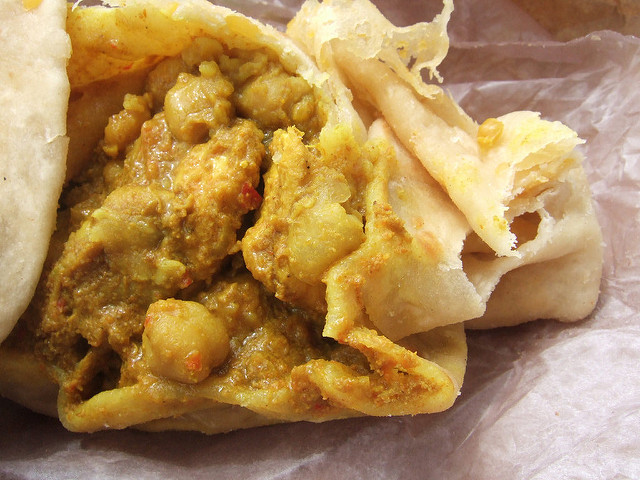
Anthony usually includes oysters on his tours, but since neither my mom nor I are particularly lovers of things from the sea, he makes an alteration and takes us to eat beef roti back in Port of Spain. Again he has selected this location for no other reason that it is his favorite roti stand and where he would chose to eat should he be dining alone or with local friends.
Roti is a Hindu word for bread. In Trinidad, as you may have guessed by now, roti is a bit different than in other parts of the world where it is shredded and used to dip into food. Here the flatbread is used as a wrap and filled with curried beef or chicken.
Like most dishes we’ve enjoyed, the beef roti is full of pepper. Anthony explains that locals believe pepper cuts alcohol and thus its very common to have a meal like roti before, during or after a night of liming.
Shawarma
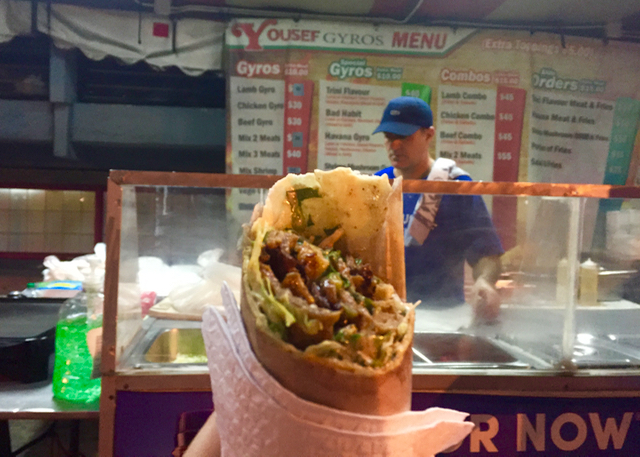
For our last stop of the evening we visit a gyro stand along Ariapita Avenue, one of the city’s most popular districts for nightlife. Music and smiles pour all around as we eat a shawarma or gyro filled with lamb. This stand is operated by Syrian refugees – one of the newest immigrant populations to make the island their home. Anthony explains that they have already modified their recipes to conform to local tastes.
“We as a people, we have developed a particular taste that we like,” Anthony says. “Anyone who comes here adapts their cooking to our taste. Soon we won’t know where this [dish] came from. It will just be Trini.”
As our evening ends the streets swell with locals in full lime mode. Some are dancing, some are talking, some are eating, all seem swept up by the peaceful contentment that comes from living in the moment. Thanks to Anthony I’ve received by first lesson liming. I hope it won’t be my last.
To book a tour with Anthony, visit TrinidadFoodTours.com.


